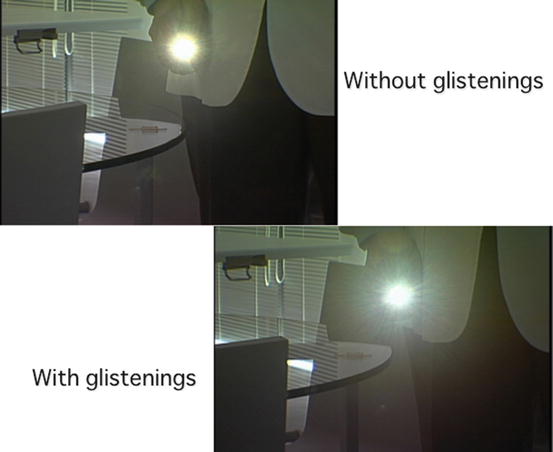16.1 Introduction
16.1.1 Glistenings
Many small particles may be generated in the optic of hydrophobic acrylic intraocular lenses (IOLs) after surgery [1, 2]. Since these particles appear to be shiny when observed by a slit-lamp microscope, they are called glistenings (Fig. 16.1). The particles are spherical or prolate spherical with a diameter of about 10 μm, transparent in color, but may appear to be light brown when it reflects inside the eye. They are not observed immediately after surgery, but come to be formed after a few months postoperatively. It is known that they do not disappear once they are formed, but that they do not increase beyond a certain level [3]. Glistenings are formed by the condensation of water from aqueous fluid penetrating into the material. Since small glistenings are observed in silicone lenses as well [4–6], they are not a phenomenon peculiar to acrylic materials, but a problem of hydrophobic soft materials as a whole.


Fig. 16.1
An optical micrograph of glistenings. Reprinted from Miyata et al. [3] with permission from Springer
16.1.2 Causes of Glistenings
Plastic, the IOL’s material, absorbs a little water when immersed. The water absorption rate (=amount of water absorption/lens weight [when dry]) is less than 1 % with hydrophobic acrylics. This water moves between the gaps of the polymer as water vapor, which is not visible. However, when phase separation occurs for some reason, it becomes a water molecule and accumulates and then becomes visible by slit-lamp microscope as a water particle. If the particles are very small, they appear to be white cloudings, and if they are large, they appear to be granular-like glistenings [7], Temperature change is considered as one of the reasons for phase separation [3, 8]. From an experiment, it was found that when IOLs are immersed in warm water, the temperature of the water decreases, and glistenings occur [2, 3]. It is probable that a drop in temperature causes oversaturation of water vapor in the IOL material, resulting in phase separation [9]. In addition, some IOLs are susceptible to glistenings and others are not. This is due to the difference in materials, and even the same acrylic resins differ in physical properties. In general, acrylic resins which have high molecular weight are more susceptible to glistenings because gaps are easily formed in the material. Furthermore, materials with a larger change in water absorption rate by temperature tend to be more susceptible to glistenings [10]. IOLs should be transparent by nature, so it is undesirable when opacification such as glistenings occur. There seem to be many clinicians who are concerned about the influence of glistenings on the visual function of patients.
16.2 Influence on Visual Function
According to the studies on the influence of glistenings on visual function examined by clinical examination, it was reported that the visual acuity of patients does not decrease even if glistenings occur [2, 11]. While some studies demonstrated that there is no influence on contrast sensitivity [2, 12], there are other reports that have shown there is a partial influence [13, 14]. Meanwhile, in the investigation in which the modulation transfer function (MTF) of the IOLs with experimentally formed glistenings was measured and the influence of glistenings was investigated from the optical property of the IOLs, it was found that there was no influence of glistenings at clinically observed levels on the optical property of the IOLs and that the influence on visual function was slight [15].
16.2.1 Glistenings in Monofocal IOLs
A 3CCD camera was set on the retinal position of optical model eyes in which IOLs can be incorporated, and the images of vision through the IOLs were observed. When the vision through an acrylic IOL (AcrySof MA60BM, +20.0 D, Alcon, Inc.) with experimentally formed glistenings was compared with that through the same control IOLs without glistenings (Fig. 16.2), no difference was observed in the usual scenery between the two visions. However, when light was emitted in the model eyes using a penlight, it was observed that the glare could be strongly seen into the IOL with glistenings (Fig. 16.3). Since the glare could be slightly seen in the control IOL without glistenings, an increase in glare due to glistenings may not be noticed by patients, but it is necessary to understand the possibility that glistenings may cause light scattering.


Fig. 16.2
An acrylic IOL with experimentally formed glistenings. Warm water experiment was performed in the acrylic IOL (AcrySof MA60BM +20.0D, Alcon Inc.) and many glistenings (arrow) were formed (below: high-power field)




